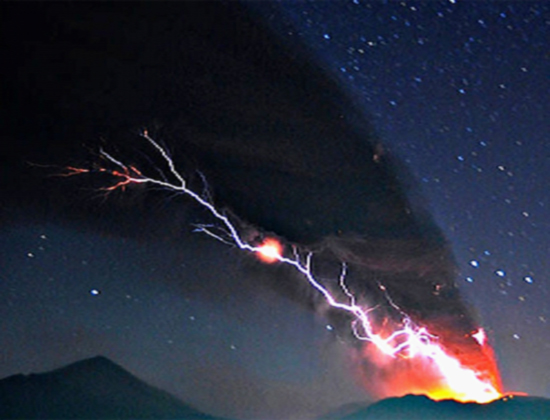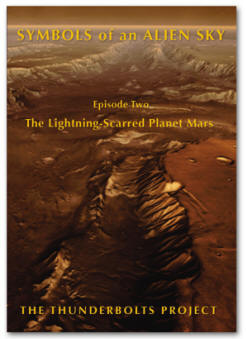|

Lightning erupts from the crater of
Mount Shinmoedake on the island of
Kyushu in Japan.
© Reuters New Agency
Earthquakes and Volcanoes
Sep
08, 2011
Lightning discharges in the
atmosphere are familiar, but what
about the ones underground?
The electrical phenomenon we call
lightning is not well understood.
The most common interpretation
involves the circulation of water
vapor up and down through clouds in
a process called convection. Water
is heated by the Sun until it
evaporates, rising into the air
where it collects into clouds. The
water vapor continues to rise higher
and higher, finally cooling enough
to condense back into liquid.
Earth's gravity then pulls it back
to the surface where the cycle
repeats.
According to consensus opinions,
water droplets tend to collide
during convection, knocking
electrons off one another, creating
a charge separation. Electrons
accumulate in the lower portion of
the cloud, where it acquires a
negative charge. As the droplets
that have lost an electron continue
to rise, they carry a positive
charge into the top of the cloud.
The regions of charge
differential, or charge separation,
cause an electric field to form
between them, with a strength
directly proportional to the amount
of charge in the cloud. The electric
field can become so powerful that it
repels electrons in the Earth's
surface, forcing it to become
positively charged. A conductive
pathway between the two regions can
initiate a lighting leader stroke
that eventually connects with some
positive streamer rising from the
ground.
Such a process cannot explain
volcanic lightning. Most planetary
scientists assume that the cause is
similar, but there is no
experimental evidence to confirm the
idea.
Over the last two hundred years
of reporting, lightning has been
seen in the ash clouds spewing from
numerous volcanic eruptions.
Gigantic branching displays were
photographed during the
Mt. Chaiten eruption in
May of 2008. There were reports of
ball lightning bigger than beach
balls rolling along the ground when
Mt. St. Helens erupted in 1981.
Eyjafjallajökull produced
flashes that lit up the sky for many
kilometers.
Large "telluric currents" have
been found circulating through
Earth's crust because our magnetic
field induces current flow in
conductive strata. Thousands of
amperes flow beneath the surface,
varying according to conductivity.
Since the Sun can affect Earth's
magnetic field through geomagnetic
storms, fluctuations in telluric
currents can occur when there is an
increase in sunspots or solar
flares, because they create
oscillations in the ionosphere.
Sometimes
earthquakes can produce
flashes of light and other luminous
events, as well. Ball lightning has
been reported accompanying
earthquakes, as have bright,
colorful cloud-like formations
floating in the sky above the
fractured strata. It is not
surprising that glow discharges
occur before and after earthquakes:
compressing quartz creates a flow of
electric current. That is one reason
why radio noise can be detected
coming from areas under extreme
stress. Is that stress only due to
compression?
Quartz reacts to stress by
producing electricity, but when
electric current flows through
quartz it vibrates with a frequency
coincident with the watts of power
supplied to it. In a previous
Picture of the Day, our planet was
compared to a capacitor, capable of
being charged and discharged by
external electric fields.
A capacitor stores electric
charge. Capacitors are constructed
of two conductors, or "plates,"
separated by a dielectric insulator.
Electric charge on one plate
attracts an opposite charge to the
other, resulting in an electric
field between them. As the
capacitor's charge increases, its
electric field increases, stressing
the insulator's ability to separate
opposite charges. If a high enough
potential grows between the two
conductive plates, the dielectric
insulator will fail and the
capacitor will short circuit,
suddenly releasing the stored
energy.
It is that phenomenon that most
likely contributes to atmospheric
lightning discharges. Stored
electrical energy in the clouds and
in the ground overcome the
atmosphere's ability to keep the two
charges separate, so they reach out
to each other as "leader strokes."
When the two lightning leaders meet,
a circuit between the clouds and the
ground (or between one cloud and
another) is completed and a burst of
electric current flashes along the
conductive pathway.
Since magma can be considered a
form of liquid plasma, it can also
conduct electricity. As the
ionosphere is charged up by solar
flares, opposite charge is attracted
to subterranean magma. Electric
currents in plasma pinch down into
filaments and form double layers.
Electromagnetic forces between
current filaments and between double
layers can cause sudden pressure
variations.
If, as stated above, the charge
differential between layers becomes
too great, a double layer can
explode, releasing all of its energy
flow instantaneously. So,
earthquakes can be considered a form
of underground lightning. If there
is a break in the strata, permitting
magma to reach the surface, the arc
discharge might connect to the
outside and a lightning bolt will
leap from the cone of a volcano.
If earthquakes are underground
lightning bolts, then perhaps
seismic waves are the thunderclaps.
In that case, it seems likely that
the majority of energy release
during an earthquake is not from the
fracturing and movement of rock
strata, but is the result of
electrical energy detonating within
the matrix.
Stephen Smith
 New
DVD New
DVD
The Lightning-Scarred
Planet Mars
A video documentary that could
change everything you thought you
knew about ancient times and
symbols. In this second episode of
Symbols of an Alien Sky, David
Talbott takes the viewer on an
odyssey across the surface of Mars.
Exploring feature after feature of
the planet, he finds that only
electric arcs could produce the
observed patterns. The high
resolution images reveal massive
channels and gouges, great mounds,
and crater chains, none finding an
explanation in traditional geology,
but all matching the scars from
electric discharge experiments in
the laboratory. (Approximately 85
minutes)
Video Selections
Order Link
|





 New
DVD
New
DVD

